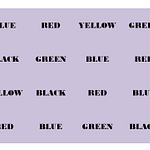Imagine that you receive a party invitation where the dress code is formal and casual. Will you be confused? What would you do? We send such conflicting instructions to the brain more often than we realize.
Take the following example.
Step 1: Try and read the following words and time yourself.
Piece of cake, you said!
Step 2: Now try to read aloud the colour of the following words. Time yourself.
Quite simple, so far!
Step 3: Let’s add another dimension to the test. Read aloud the colour of the following words. Time yourself.
What did you find? How different are the 3 timings?
In step 3, try reading the words and not the colour. Which is more difficult for you? Is it naming the colour or reading the word?
The brain functions at work
Different parts of the brain and different neural circuits are employed by the brain to perform different functions. What happens when one function hinders the performance of another function?
John Ridley Stroop first reported this effect and popularized the Stroop Test to test brain function. It has been used as the basis of countless neural and psychological experiments and studies.
In step 1, the brain is focused entirely on reading as all the words are of the same colour.
In step 2, the brain has to focus on the colour of the words. However, the autopilot part of the brain will read the words as well. In this case, the reading does not hinder the colour recognition drastically as the colour of the word and the word itself correspond. The brain functions are relatively congruent.
In step 3, the reading of the word hinders the colour recognition. So to be effective, the brain has to suspend or overcome the reading in order to recognize the colour accurately. The brain functions, in this situation, are incongruent.
Note: Some people find reading the word in step 3 to be more difficult than identifying the colour. What is easy indicates which neural circuit and function is stronger in the brain.
You will find that if in step 3, we replace the words with just bands of colour, your test scores will shoot up dramatically. With the colour bands, there is no conflict in brain functions.
Try this test with kindergarten children who have learnt to identify colours but have not started reading yet. They will ace the test in all 3 steps. To them, there is no conflicting brain function at work as they have not learnt to read.
Similarly, if we replace the words with other non-related words like names of people or places, the scores improve.
Researchers have found that with age, difference in scores at step 2 and 3 increase, indicating that our brain takes longer to process and integrate conflicting functions and messages.
One version of the Online Brain Function – Stroop Colour Test





